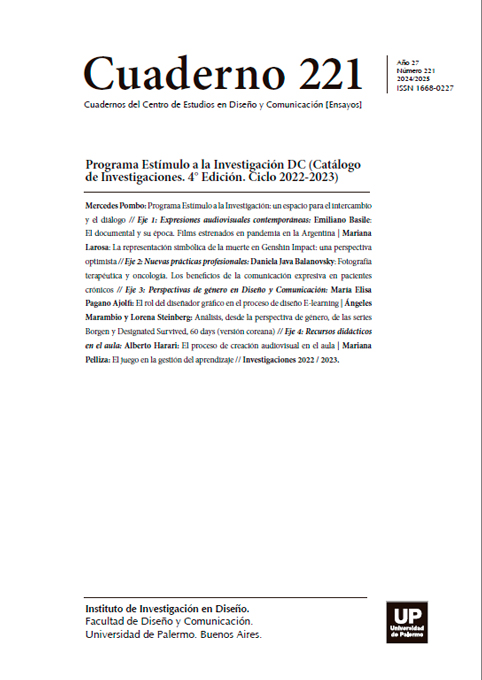La representación simbólica de la muerte en Genshin Impact: una perspectiva optimista
Resumo
Este projeto analisa a representação da morte no videogame chinês Genshin Impact.
Referências
Adams, S. (2014). Colorpedia. Diccionario del color para diseñadores. Barcelona: Promopress.
Barthes, R. (1970). Retórica de la imagen. Buenos Aires: Tiempo Contemporáneo Belting,
H. (2012). Antropología de la imagen. City Bell: Katz editores.
Díez, P. (2015). ¿Por qué el cuatro es el número de la mala suerte en China?. ABC Internacional. Disponible en https://www.abc.es/internacional/20150403/abci-china-cuatro-malasuerte-201504011204.html?ref=https%3A%2F%2Fwww.google.com%2F
Diffrient, D. (2018). Hong Kong Horror Cinema. Edinburgh: Edinburgh University Press.
Falero, A. (2007). Aproximación al shintoísmo. Salamanca: Amarú.
Farca, G. (2011). Narratives in Video Games. ResearchGate. Disponible en https://www.researchgate.net/publication/309232813_Narratives_in_Video_Games
Gómez Martín, D. (2015). Iconografía de la muerte en el arte moderno occidental. San Cristóbal de La Laguna: Universidad de La Laguna.
Hernández-Araico, S. (1987). Mitos, simbolismo y estructura en Apolo y Climene y el hijo del sol, Faetón. Liverpool: Bulletin of Hispanic Studies.
HoYoLAB (2023). HoYoWiki. Disponible en https://wiki.hoyolab.com/pc/genshin/home
Ladner, M. (2022). Significado del color morado en la cultura china. Filosofia.co. Disponible en https://filosofia.co/definiciones/significado-del-color-morado-en-la-cultura-china/
Lester, P. (2013). Syntactic Theory of Visual Communication. Indiana: Indiana University Press.
Luchko, E. (2021). Representation of the ancient myth about Hyperion in modern graphic literature. Czestochowa: Scientific Journal of Polonia University.
Martínez, C. (2017). Una mariposa nocturna que ha inspirado a célebres artistas. Museo Nacional de Ciencias Naturales (España) Disponible en https://www.mncn.csic.es/es/comunicacion/blog/una-mariposa-nocturna-que-ha-inspirado-celebresartistas#:~:text=El%20g%C3%A9nero%20Acherontia%20debe%20su,los%20muertos%20en%20su%20barca.
Mitchell, W. (2009). Teoría de la imagen. Madrid: Akal.
Panofsky, E. (1998). Estudios sobre iconología. Madrid: Alianza Editorial.
Pastoriza, M. (2022). ¿Cuántos jugadores tiene Genshin Impact? Recuento total (agosto 2022). Disponible en https://www.dexerto.es/genshin-impact/cuantos-jugadores-tiene-genshinimpact-recuento-t otal-octubre-de-2021-1450416/
Pérez Rufí, J. y Pérez Rufí, M. I. (2018). Estereotipos del cine de zombis y televisión: The Walking Dead. Razón y palabra, 22 (103), p. 122-139.
Pilipovic, S. (2023). How many people play Genshin Impact? — 2023 statistics Disponible en https://levvvel.com/genshin-impact-statistics/
Prósperi, G. (2021). Logos y Hades. La Plata: Anales del Seminario de Metafísica.
Samuels, A. (2017). Symbolism In Videogames: Finding The Balance Between Dark And Light. The Ontological Geek. Disponible en http://ontologicalgeek.com/symbolism-in-videogames-finding-the-balance-between-dark-an d-light/
Santander Oliván, M. (2009). Occidente y la caída de la dinastía Qing: del Imperio a la República de China. Disponible en https://dialnet.unirioja.es/servlet/articulo?codigo=3264032
Statista (2023). Global Genshin Impact app downloads 2020-2022. Disponible en https://www.statista.com/statistics/1251724/genshin-impact-number-of-downloads-worldwid e/
TGG (2022). What is the Average Player Age in Genshin Impact? Disponible en https://theglobalgaming.com/gaming/genshin-impact-average-player-age
Thompson, D. (2012). Designing serious video games for health behavior change: current status and future directions. Disponible en https://www.researchgate.net/publication/38066136_Journal_of_Diabetes_Science_and_Technology_and_the_Diabetes_Technology_Community
Udonis (2023) The Secret Behind Genshin Impact Advertising Strategy. Disponible en https://www.blog.udonis.co/mobile-marketing/mobile-games/genshin-impact-advertising#:~:text=Genshin%20Impact%20Demographics&text=The%20gender%20distribution%20is%20quite,the%20average%20age%20is%2035
Los autores/as que publiquen en esta revista ceden los derechos de autor y de publicación a "Cuadernos del Centro de Estudios de Diseño y Comunicación", Aceptando el registro de su trabajo bajo una licencia de atribución de Creative Commons, que permite a terceros utilizar lo publicado siempre que de el crédito pertinente a los autores y a esta revista.


